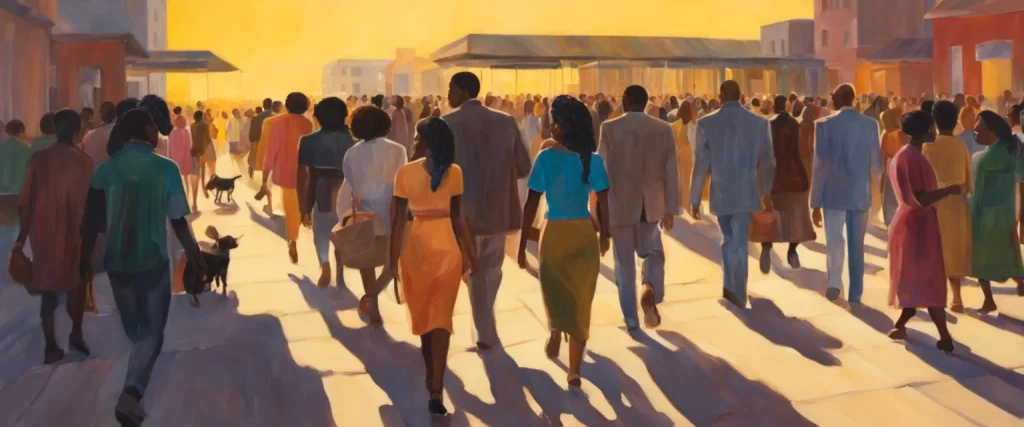—Caste & The Warmth of Other Suns
In the vast realm of literature, there exist profound works that intricately delve into the tormented spheres of human existence, striving to understand the multifaceted nature of social dynamics. Isabel Wilkerson, a renowned author and Pulitzer Prize-winning journalist, has exhibited a remarkable ability to shed light on the often obscure layers of human experience, enabling readers to engage with the struggles of marginalized communities in America. In her seminal works, “Caste” and “The Warmth of Other Suns,” Wilkerson explores the far-reaching consequences of a deeply entrenched social hierarchy and seeks to empower readers with a profound understanding of the ramifications of caste systems and mass migration.
I. Contextualizing “Caste”:
“Caste” represents a noteworthy addition to Wilkerson’s body of work, wherein she critically examines the persistence and pervasiveness of caste systems in various societies. Drawing from an extensive range of historical events and personal narratives, Wilkerson lays bare the inherent similarities between the Indian caste system, the Nazi regimes, and the enduring hierarchy in the United States. By unmasking the invisible and nuanced structures of caste, Wilkerson endeavors to challenge readers’ assumptions and broaden their understanding of the systems that shape human lives.
II. Exploring “The Warmth of Other Suns“:
In contrast, “The Warmth of Other Suns” embarks on a compelling journey that delves into one of the most significant episodes in American history – the Great Migration. Amplifying the voices of millions who ventured northward and westward to escape the oppressive realities of Jim Crow and seek opportunities for a better life, Wilkerson artfully chronicles the harrowing experiences endured by African Americans during this transformative era. By intertwining intimate narratives with meticulous historical research, she highlights the multifaceted challenges faced by these courageous individuals as they sought refuge and freedom from the suffocating grip of racism.
III. Common Threads and Divergent Perspectives:
While “Caste” and “The Warmth of Other Suns” may appear to explore distinct aspects of societal divisions, they share an underlying connective thread that revolves around the complexities of marginalization and the detrimental impact of systemic discrimination. Through her powerful storytelling, Wilkerson prompts readers to recognize the commonalities between caste systems and racial hierarchies, emphasizing that the oppression experienced by different groups can stem from strikingly similar roots.
However, these works also offer distinct perspectives. “Caste” provides a comprehensive global outlook, drawing parallels across societies and exploring the consequences of such hierarchies on a global scale. On the other hand, “The Warmth of Other Suns” grounds itself in intimate personal narratives, tracing the transformative journeys undertaken by African Americans in their quest for freedom and equality.
IV. Significance and Aims of the Comparative Study:
This comparative study seeks to delve deep into the shared thematic elements and diverging nuances present in “Caste” and “The Warmth of Other Suns.” By analyzing the ways in which the authors unravel the complexities of caste systems and racial hierarchies, we aim to understand the inherent interconnectedness between different forms of oppression and the experiences of marginalized communities. Moreover, this study aims to shed light on the distinct perspectives offered by each work, thereby creating a comprehensive framework to explore the struggles of people who have navigated through oppressive systems in pursuit of dignity and liberation.
Intriguing and profound, “Caste” and “The Warmth of Other Suns” challenge readers to reexamine their perceptions of power, dignity, and freedom. By undertaking a comparative analysis of these two remarkable books, we embark on a journey through the intricate web of caste systems and historical migrations, ultimately seeking a richer understanding of the myriad human experiences that shape our societies.
Brief Summary of Two Books
Caste by Isabel Wilkerson
“Caste: The Origins of Our Discontents” written by Isabel Wilkerson explores the concept of caste and how it shapes society in the United States and across the world. The book draws parallels between caste systems in various societies throughout history, including India and Nazi Germany, to examine the deeply ingrained structures of privilege and hierarchy in America. Wilkerson delves into the historical roots of caste, specifically focusing on the creation of a racial caste system in the United States through slavery and Jim Crow laws. She argues that caste not only affects racial inequality but also permeates other areas of life, such as gender, education, and politics. Through extensive research and personal narratives, Wilkerson exposes the hidden ways caste influences people’s lives and offers insights into how it can be addressed for a more equitable society.
The Warmth of Other Suns by Isabel Wilkerson
“The Warmth of Other Suns” by Isabel Wilkerson is a non-fiction book that tells the story of the Great Migration, a movement of African Americans from the South to the North and West between 1915 and 1970. Through the personal narratives of three individuals, Wilkerson provides an immersive account of the challenges, aspirations, and triumphs faced by those who sought to escape racial oppression and build a better life for themselves and their families. The book explores the social, political, and economic factors that influenced this mass migration, shedding light on the enduring impact it had on America’s racial landscape.
Comparison between Two Books

Similarities in Caste
Both “Caste” by Isabel Wilkerson and “The Warmth of Other Suns” by Isabel Wilkerson discuss the concept of caste and its impact on society. Here are some similarities between the two books:
1. Exploration of the caste system: Both books provide a detailed exploration of the caste system, albeit in different contexts. In “Caste,” Wilkerson delves into the caste system in America, highlighting its origins, development, and remnants in contemporary society. In “The Warmth of Other Suns,” she focuses on the caste-like system of racial hierarchy prevalent in the United States during the Great Migration.
2. Historical context: Both books incorporate a historical perspective to explain the origins and evolution of the caste system. They provide a thorough examination of historical events, such as slavery, Jim Crow laws, and racial segregation, to shed light on how these systems influenced and perpetuated caste divisions.
3. Personal narratives: Both books feature personal narratives and stories of individuals who have experienced the effects of caste. In “Caste,” Wilkerson shares stories from various individuals across different walks of life, illustrating the pervasive impact of the caste system. Similarly, in “The Warmth of Other Suns,” she tells the stories of three African-Americans who migrated from the South to the North in search of better opportunities, highlighting the struggles they faced due to their lower caste status.
4. Intersectionality of caste: In both books, Wilkerson explores the intersectionality of caste with other aspects of identity, such as race, gender, and socioeconomic status. She examines how different forms of oppression and discrimination intersect to create a complex web of social hierarchies, resulting in the perpetuation of caste-based divisions.
5. Consequences and effects: Both books emphasize the profound and lasting impact of caste on individuals and society as a whole. They discuss how the caste system has shaped opportunities, access to resources, and social mobility for generations, leading to entrenched inequality and marginalization.
Overall, both “Caste” and “The Warmth of Other Suns” provide insightful and comprehensive analyses of the caste system and its implications. They shed light on the deep-rooted nature of caste divisions and the urgent need for transformative change in order to create a more equitable society.
Divergences in Caste
Caste by Isabel Wilkerson and The Warmth of Other Suns by Isabel Wilkerson are both groundbreaking works that explore the profound impact of social hierarchies on individuals and communities. While they delve into similar themes, there are notable divergences in their approach to casting light on the concept of caste.
The primary divergence between the two books lies in their focus and scope. In The Warmth of Other Suns, Isabel Wilkerson takes a historical approach, chronicling the Great Migration of African Americans from the South to the North and West between 1915 and 1970. Through the stories of three individuals, she examines the bravery, resilience, and challenges faced by Black Americans seeking to escape the oppressive caste system of the South. Wilkerson meticulously weaves together personal narratives and historical context to provide a comprehensive understanding of the socio-economic and political forces driving the migration.
On the other hand, Caste takes a broader and more theoretical perspective on the concept of caste, examining its influence on societies beyond the United States. Wilkerson draws parallels between the caste systems of America, India, and Nazi Germany, highlighting the universal nature of these systems and their profound impact on human lives. By analyzing historical events and combining them with sociological perspectives, Wilkerson distills the essence of caste as a complex web of social hierarchy embedded deep within societies.
Another key divergence between the two books is the emphasis placed on different aspects of caste. In The Warmth of Other Suns, Wilkerson explores the intersections of race, caste, and migration, focusing on the experiences of Black Americans seeking liberation from the rigidly enforced racial caste system in the South. The book sheds light on the systemic injustices faced by African Americans and the immense sacrifices made to achieve greater freedom and opportunity in the North and West.
In Caste, Wilkerson broadens the notion of caste to encompass the social divisions and hierarchies present in various societies. By examining caste as an inherent feature of human society, she illustrates how the rigid social order perpetuates discrimination and inequality. Wilkerson highlights the enduring consequences of caste oppression, emphasizing how it manifests in various areas of life, including education, employment, wealth distribution, and access to resources.
In conclusion, while both Caste and The Warmth of Other Suns explore the overarching concept of caste and its implications for marginalized communities, they diverge in focus and scope. The Warmth of Other Suns delves into the historical narratives of African Americans’ migration, while Caste draws comparisons between different caste systems across the globe. Both books contribute significantly to our understanding of the far-reaching impacts of caste and oppression, but approach the subject matter from distinct angles.

Conclusion
Both books, Caste by Isabel Wilkerson and The Warmth of Other Suns by Isabel Wilkerson, are highly acclaimed and worth reading for different reasons.
Caste: The Origins of Our Discontents is Wilkerson’s most recent work, published in 2020. In this book, she explores the roots and consequences of caste systems, drawing comparisons between the caste system in India, the caste-like system under Nazi Germany, and the lasting effects of racial hierarchies in the United States. Caste delves into the deeply ingrained social structures that perpetuate inequality and examines how they shape society today. It offers a thorough analysis of systemic racism and calls for a reimagining of social structures.
The Warmth of Other Suns: The Epic Story of America’s Great Migration, published in 2010, is Wilkerson’s debut book. It tells the story of the Great Migration, which refers to the mass movement of Black Americans from the South to Northern and Western cities between 1915 and 1970. The Warmth of Other Suns weaves together the personal narratives of three individuals who made this journey, showcasing their struggles, triumphs, and the impact they had on the cities they settled in. This book provides a vivid portrayal of the challenges faced by Black Americans during the Great Migration and sheds light on the broader social and political implications of this historic movement.
Ultimately, the choice between Caste and The Warmth of Other Suns depends on personal preferences and interests. If you are interested in exploring the origins and consequences of caste systems, and in understanding how they intersect with racial inequality, Caste would be the more pertinent choice. On the other hand, if you are fascinated by historical narratives and want to delve into the personal stories of those who participated in the Great Migration, The Warmth of Other Suns would be the more fitting option. Both books offer valuable insights and contribute to a deeper understanding of race, inequality, and American history.



